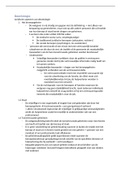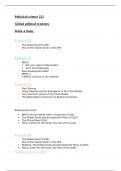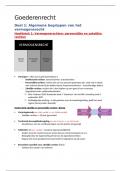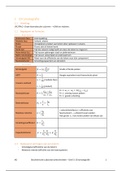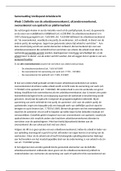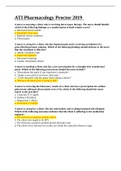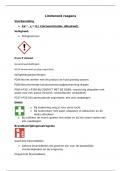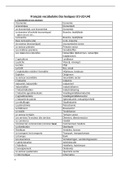Section 1: The establishment and early days of the Weimar Republic, 1918-24
Chapter 1: Impact of war, the political crisis of Oct - Nov 1918, and the establishment of
the Weimar Constitution
Germany’s defeat in war:
1. The failure of the Schlieffen plan [fighting war on two fronts, East/ West] resulted in a stalemate,
a balance of military on both sides.
2. Further strain was caused by the allies naval blockade/ lack of import supplies.
3. Strength of allies also determined German failure → Britain + France had overseas personnel,
resources, supplies + USA’s entry into war 1917.
4. Limitations of war economy.
By Nov 1918 German forces retreated along the length of the Western Front + at the same time main ally
Austria-Hungary was defeated on other fronts.
- General Ludendorrf concluded the only way to survive the humiliating defeat of war was to ask
allies for armistice negotiations on 29 Sep 1918.
- Armistice: an agreement to suspend fighting in order to allow a peace treaty to be negotiated.
Wilson’s 14 points:
- The President's 14 points were designed to fairly deal with aftermath of war + prevent future wars.
- Return of alsace Lorraine to France [punitive/ specific to Germany].
- Establishment of League of Nations to monitor disputes.
- Self determination → nations should rule themselves with general disarmament.
October reforms:
Military defeat was a profound shock for Germany → led to the end of Kaiser’s rule + establishment of
democratic form of government.
- Weimar Republic, established in Germany in wake of military defeat and political revolution →
Lasted less than 15 years, plagued from beginning by economic crises + political divisions.
,In Oct Ludndorff recommended a series of reforms to effectively end the Kaiser's rule.
- Prince Max Baden appointed as chancellor → he was responsible to reichstag + established a
new government based on majority parties.
- Armed forces under control of civil government.
- Reforms were a major constitutional transformation pinned as a “revolution from above” not as
a result of social/ political pressure but instead to preserve Kaiser's rule + save Germany from
humiliation.
- All this proves that Germany had been influenced by the military for ulterior motives and it was not
a constitutional revolution.
Peace note:
- 3 Oct: Prince Max’s letter to President Wilson asking for an armistice.
- Wilson took 3 weeks to reply largely due to suspicion that Germany was using time to regroup +
plan another offensive.
- 24 Oct: Wilson replied to Prince Max’s request → said that Germany needs to evacuate occupied
territories, end submarine warfare + fully democratise its political system.
- 26 Oct: Ludendorff could not accept this → resigned and fled to Sweden.
- 28 Oct: Kaiser introduced further reforms making the Chancellor accountable to the Reichstag.
Impact on German people:
- Asking for armistice shattered morale of people + armed forces → it was an admission of loss.
- People learned the truth → undermining respect for kaiser, military + politicians.
- People who had faced the brunt of war and its socio-economic effects were no longer compliant.
- 22 Oct 1918: During strike in Friedrichshafen workers shouted “the Kaiser is a scoundrel” /
“up with the German republic.”
- 28 Oct 1918: Futile last attempt in Wilhelmshaven → military high command ordered an attack
on British ships in the English Channel, 2 crews refused igniting naval mutiny, beginning a much
broader revolutionary movement.
November Revolution of 1918:
1. Unrest in the navy spreads to the main naval base at Kiel.
, - 3 Nov 1918: sailors at Kiel mutinied against officers + took control of the base.
2. On the following day the revolt spread to the city, and workers + soldiers councils were
established, mirroring the Russian Revolution of 1917.
- By 6 Nov 1918 workers + soldiers councils springing up spontaneously all over; even
though it seemed similar to Communist revolution most members just wanted Kaiser's
abdication + democratic republic.
3. 8 Nov 1918: Bavarian republic proclaimed: socialist Eisner proclaimed Bavaria an independent.
democratic socialist republic.
- Historian Carr “this was the decisive moment in the German revolution”, + indicated Max
had lost control.
4. 9 Nov 1918 in Berlin SPD called on workers to join a general strike to force Kaiser to abdicate +
threatened to withdraw support unless he did.
- Max, desperate as he can’t govern without SPD, releases false statement that Kaiser had
abdicated → he then resigns the same day + Ebert is left in command as leader of SPD.
- Provisional coalition in charge until national election to vote for parliament.
- Groener told the Kaiser that the army would no longer support him.
5. 10 Nov 1918 Kaiser was forced to abdicate and leave for Holland, a neutral country.
The struggle for power
Ebert’s constituent Assembly
- Ebert was not a revolutionary, believed in evolutionary change through parliamentary elections +
reforms, even though he came into power through a revolutionary act.
- Constituent assembly: elected body with specific task of drawing up a new constitution.
- Prior to the creation of a new constitution Ebert urged essential services to stay running, to avoid
street demonstrations + maintain law/ order → problem was that his authority did not extend
beyond Berlin where disorder and violence was on the rise.
, - After armistice and the demobilisation of much of the army, bands of angry, disillusioned +
workless, ex-soldiers roamed the streets → street demonstrations, strikes + armed clashes
became regular occurrences.
Socialist groups + parties in 1918:
SPD:
- Founded: in 1875 as a Marxist socialist party committed to revolution.
- Leaders: Ebert + Scheidemann.
- Aims: Wanted moderate socialist republic with democratic elections, basic personal freedoms,
welfare improvements, gradual nationalisation of industry, continuity + order → supported German
entry into war.
- Supported: by working class voters + in 1912 became largest party in Reichstag.
- Membership: 1 million.
Spartacist league [KPD]:
- Founded: In 1916, by a more revolutionary minority group from the SPD → name was changed to
KPD in Jan 1919.
- Leaders: Karl Liebknecht + Rosa Luxemburg.
- Aims: Wanted republican government controlled by workers + soldiers councils, welfare benefits,
nationalisation, workers control of major industries, disbanding of the army, creation of local
workers’ militias → opposed WW1.
- Support: workers would often join them on their rallies and demonstrations in the streets.
- Membership: 5,000.
USPD:
- Founded: in 1917 breakaway minority group from left of SPD.
- Leaders: Hugo Haase
- Aims: Wanted national reichstag working with workers + soldier councils, welfare improvements,
nationalisation of industry, breaking up large estates, reform of army, creation of national militia →
opposed WW1
- Support: grew in strength during weariness of war.
- Membership: 300,000.
Chapter 1: Impact of war, the political crisis of Oct - Nov 1918, and the establishment of
the Weimar Constitution
Germany’s defeat in war:
1. The failure of the Schlieffen plan [fighting war on two fronts, East/ West] resulted in a stalemate,
a balance of military on both sides.
2. Further strain was caused by the allies naval blockade/ lack of import supplies.
3. Strength of allies also determined German failure → Britain + France had overseas personnel,
resources, supplies + USA’s entry into war 1917.
4. Limitations of war economy.
By Nov 1918 German forces retreated along the length of the Western Front + at the same time main ally
Austria-Hungary was defeated on other fronts.
- General Ludendorrf concluded the only way to survive the humiliating defeat of war was to ask
allies for armistice negotiations on 29 Sep 1918.
- Armistice: an agreement to suspend fighting in order to allow a peace treaty to be negotiated.
Wilson’s 14 points:
- The President's 14 points were designed to fairly deal with aftermath of war + prevent future wars.
- Return of alsace Lorraine to France [punitive/ specific to Germany].
- Establishment of League of Nations to monitor disputes.
- Self determination → nations should rule themselves with general disarmament.
October reforms:
Military defeat was a profound shock for Germany → led to the end of Kaiser’s rule + establishment of
democratic form of government.
- Weimar Republic, established in Germany in wake of military defeat and political revolution →
Lasted less than 15 years, plagued from beginning by economic crises + political divisions.
,In Oct Ludndorff recommended a series of reforms to effectively end the Kaiser's rule.
- Prince Max Baden appointed as chancellor → he was responsible to reichstag + established a
new government based on majority parties.
- Armed forces under control of civil government.
- Reforms were a major constitutional transformation pinned as a “revolution from above” not as
a result of social/ political pressure but instead to preserve Kaiser's rule + save Germany from
humiliation.
- All this proves that Germany had been influenced by the military for ulterior motives and it was not
a constitutional revolution.
Peace note:
- 3 Oct: Prince Max’s letter to President Wilson asking for an armistice.
- Wilson took 3 weeks to reply largely due to suspicion that Germany was using time to regroup +
plan another offensive.
- 24 Oct: Wilson replied to Prince Max’s request → said that Germany needs to evacuate occupied
territories, end submarine warfare + fully democratise its political system.
- 26 Oct: Ludendorff could not accept this → resigned and fled to Sweden.
- 28 Oct: Kaiser introduced further reforms making the Chancellor accountable to the Reichstag.
Impact on German people:
- Asking for armistice shattered morale of people + armed forces → it was an admission of loss.
- People learned the truth → undermining respect for kaiser, military + politicians.
- People who had faced the brunt of war and its socio-economic effects were no longer compliant.
- 22 Oct 1918: During strike in Friedrichshafen workers shouted “the Kaiser is a scoundrel” /
“up with the German republic.”
- 28 Oct 1918: Futile last attempt in Wilhelmshaven → military high command ordered an attack
on British ships in the English Channel, 2 crews refused igniting naval mutiny, beginning a much
broader revolutionary movement.
November Revolution of 1918:
1. Unrest in the navy spreads to the main naval base at Kiel.
, - 3 Nov 1918: sailors at Kiel mutinied against officers + took control of the base.
2. On the following day the revolt spread to the city, and workers + soldiers councils were
established, mirroring the Russian Revolution of 1917.
- By 6 Nov 1918 workers + soldiers councils springing up spontaneously all over; even
though it seemed similar to Communist revolution most members just wanted Kaiser's
abdication + democratic republic.
3. 8 Nov 1918: Bavarian republic proclaimed: socialist Eisner proclaimed Bavaria an independent.
democratic socialist republic.
- Historian Carr “this was the decisive moment in the German revolution”, + indicated Max
had lost control.
4. 9 Nov 1918 in Berlin SPD called on workers to join a general strike to force Kaiser to abdicate +
threatened to withdraw support unless he did.
- Max, desperate as he can’t govern without SPD, releases false statement that Kaiser had
abdicated → he then resigns the same day + Ebert is left in command as leader of SPD.
- Provisional coalition in charge until national election to vote for parliament.
- Groener told the Kaiser that the army would no longer support him.
5. 10 Nov 1918 Kaiser was forced to abdicate and leave for Holland, a neutral country.
The struggle for power
Ebert’s constituent Assembly
- Ebert was not a revolutionary, believed in evolutionary change through parliamentary elections +
reforms, even though he came into power through a revolutionary act.
- Constituent assembly: elected body with specific task of drawing up a new constitution.
- Prior to the creation of a new constitution Ebert urged essential services to stay running, to avoid
street demonstrations + maintain law/ order → problem was that his authority did not extend
beyond Berlin where disorder and violence was on the rise.
, - After armistice and the demobilisation of much of the army, bands of angry, disillusioned +
workless, ex-soldiers roamed the streets → street demonstrations, strikes + armed clashes
became regular occurrences.
Socialist groups + parties in 1918:
SPD:
- Founded: in 1875 as a Marxist socialist party committed to revolution.
- Leaders: Ebert + Scheidemann.
- Aims: Wanted moderate socialist republic with democratic elections, basic personal freedoms,
welfare improvements, gradual nationalisation of industry, continuity + order → supported German
entry into war.
- Supported: by working class voters + in 1912 became largest party in Reichstag.
- Membership: 1 million.
Spartacist league [KPD]:
- Founded: In 1916, by a more revolutionary minority group from the SPD → name was changed to
KPD in Jan 1919.
- Leaders: Karl Liebknecht + Rosa Luxemburg.
- Aims: Wanted republican government controlled by workers + soldiers councils, welfare benefits,
nationalisation, workers control of major industries, disbanding of the army, creation of local
workers’ militias → opposed WW1.
- Support: workers would often join them on their rallies and demonstrations in the streets.
- Membership: 5,000.
USPD:
- Founded: in 1917 breakaway minority group from left of SPD.
- Leaders: Hugo Haase
- Aims: Wanted national reichstag working with workers + soldier councils, welfare improvements,
nationalisation of industry, breaking up large estates, reform of army, creation of national militia →
opposed WW1
- Support: grew in strength during weariness of war.
- Membership: 300,000.


